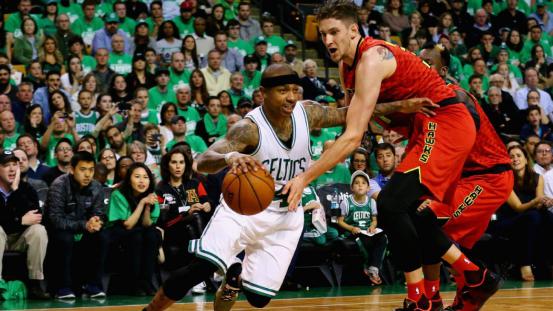- Commissioner’s statement on Ventura, Marte
- Ronnie O’Sullivan: Masters champion ‘felt so vulnerable’ in final
- Arron Fletcher Wins 2017 WSOP International Circuit Marrakech Main Event ($140,224)
- Smith challenges Warner to go big in India
- Moncada No. 1 on MLB Pipeline’s Top 10 2B Prospects list
- Braves land 2 on MLB Pipeline’s Top 10 2B Prospects list
- Kingery makes MLB Pipeline’s Top 10 2B Prospects list
- New Zealand wrap up 2-0 after Bangladesh implosion
- Mathews, Pradeep, Gunathilaka to return to Sri Lanka
- Elliott hopes for rain for Poli
Eight things to watch in Celtics-Hawks, Game 5
- Updated: April 26, 2016

12:00 AM ET
Brad Stevens, genius of the whiteboard, has openly admitted to coaching plagiarism. So it was fitting on several levels that his tireless Boston team opened Game 4 of the first round’s most exciting series with a play ripped right from the Kyle Korver chapter of Mike Budenholzer’s playbook:
With Avery Bradley out and Kelly Olynyk limited, the Celtics face borderline fatal spacing strangulation whenever Isaiah Thomas has the ball. Starting in the second half of Game 2, and especially in Game 3, Stevens loosened things by having Thomas spend more time scampering around without the ball as a mini-shooting guard. That has included a lot of “split”-style actions like this, where Thomas and a teammate come together, dance around each other, and burst apart in unpredictable patterns.
Except this was one predictable, and almost certainly scripted. Boston knew Jeff Teague, overmatched so far guarding Thomas, might try to block Thomas’s path toward any potential screener — effectively playing on top of him. Thomas read that, veered away from Crowder, and set a surprise screen on Crowder’s man, Kyle Korver, offering himself up as the meat in a Hawks sandwich as Crowder sprung open.
Korver probably felt like Jerry Seinfeld when Puddy ripped off part of his routine: “THAT’S MY MOVE!” Here is Korver pulling the trick to free Paul Millsap during a regular-season game against Boston:
Poor Kemba Walker and Frank Kaminsky had no clue what was about to hit them:
The best shooters make the best screeners. If Stephen Curry sets a pick that untangles Klay Thompson, Curry’s defender isn’t going to slide away from Curry to patrol Thompson until Thompson’s defender wriggles around Curry’s screen. Defenders are petrified to leave guys like Curry or Korver open for even a split second. Thomas isn’t near their level as a shooter, but he’s the best facsimile Boston has, and Stevens is leveraging the threat of Thomas’s shooting for all it’s worth.
The Hawks could switch this action, but that requires pitch-perfect communication, and if they do that once, Thomas will just make a different read the next time around.
And that’s the first of our Eight Things to Watch as the Hawks, after four mostly tight games, seek to regain control tonight in Atlanta:
2. Can Teague handle Thomas away from the ball?
So far, he hasn’t been up to it. Teague might survive the first cut, and maybe the second, but if Thomas worms his way around the floor for 10 or 15 seconds, Teague is breaking down at some point — smashing into a pick, taking an odd route around one, or exhaling, flat-footed, when Thomas completes one Ray Allen-style route.
Thomas away from the ball has a sort of Kyle Lowry-like quality to him: He never stands straight up, sapping his own momentum, and he’s always primed to keep moving. When he sees his defender take a break, he’s gone.
Atlanta doesn’t really have a lot of great choices. Kent Bazemore isn’t fast enough, and slotting him there would require Teague guard Evan Turner — a post threat against little guys — or some other dramatic reshuffling of defense assignments. The Hawks tried Thabo Sefolosha on Thomas during a few crunch-time possessions, but Sefolosha doesn’t start, and can’t keep up with Thomas, anyway.
Dennis Schroder has been better, and during the seven minutes he and Teague have shared the floor, Budenholzer has given him Thomas duty. Budenholzer has rarely trusted that double point guard look. Teague probably just has to be better.
The Hawks know Teague is having trouble, and so they are starting to overplay passing lanes as Thomas comes flying off screens. Boston in turn has noticed the Hawks jumping those passes, and has started to prey upon that aggression with pass fakes and well-timed drives:
With more preparation, Boston might be able to get some easy buckets out of this.
3. Can Teague and Schroder find that ISO-tastic balance?
By starting Turner over Marcus Smart, the Celtics have (mostly) accepted the cost of having Thomas defend Atlanta’s point guards — something they avoided in the first two games, when Thomas hid out on Bazemore.
Both Teague and Schroder can beat Thomas off the dribble by themselves, without the aid of a screen, whenever they’d like. That kind of one-on-one play cuts against Atlanta’s pass-happy identity, but it can be devastating, especially when they attack in semi-transition — with Thomas backpedaling, and the other Boston defenders still setting their feet.
The key for both guys is finding the right balance between probing with multiple options on the table, and rushing headlong into wild …
continue reading in source espn.go.com
